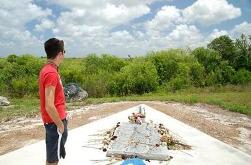 Last week, I took a trip to south Florida to see my grandma as a late Mother’s Day present. While I was down there with my friend, we went to the Valujet Airlines Flight 592 memorial site in the Everglades. Flight 592 experienced an in-flight fire back in 1996 and impacted the ground while attempting to return to Miami killing all 110 aboard the DC-9. Being involved in Aviation Safety, I knew how important it was to visit the site so that number one, the people are not forgotten and number two, that we remember our past and do not repeat our mistakes. The site was very touching and meeting a family of one of the flight attendants was also a good reminder of why I do what I do every day in the classroom.
Last week, I took a trip to south Florida to see my grandma as a late Mother’s Day present. While I was down there with my friend, we went to the Valujet Airlines Flight 592 memorial site in the Everglades. Flight 592 experienced an in-flight fire back in 1996 and impacted the ground while attempting to return to Miami killing all 110 aboard the DC-9. Being involved in Aviation Safety, I knew how important it was to visit the site so that number one, the people are not forgotten and number two, that we remember our past and do not repeat our mistakes. The site was very touching and meeting a family of one of the flight attendants was also a good reminder of why I do what I do every day in the classroom.
In April I got hired as a monorail pilot at the Walt Disney World Resort and I began my first day a few weeks after getting hired. My job is so cool! I get to interact with people from all over the world, load then drive 12 different color trains and promote a safe environment for my fellow cast members and guests.
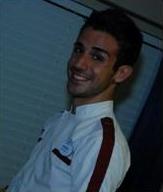 My first day on the job was fun. I got to actually take part in interacting with the guests and the trains. I learned my general duties as a monorail pilot and the safety procedures that are in place to maintain a safe yet efficient environment. My training comes in two parts; platform and drive. I will learn to actually drive the trains in about 30 days from my hire date but throughout the course of my platform training I will learn little by little the skills to successfully pilot a train.
My first day on the job was fun. I got to actually take part in interacting with the guests and the trains. I learned my general duties as a monorail pilot and the safety procedures that are in place to maintain a safe yet efficient environment. My training comes in two parts; platform and drive. I will learn to actually drive the trains in about 30 days from my hire date but throughout the course of my platform training I will learn little by little the skills to successfully pilot a train.
I also finished one of my aircraft cabin survivability projects which answered some chilling questions about the Lexington accident, the accident that changed my life and led me to pursue studies in aircraft safety.
In that accident, in a matter of just 10 minutes, people’s lives had changed forever knowing that their loved ones were dead and there was no reset button. This is why I have found that, when dealing with any accident, the hardest part of it is definitely the people. Then the investigation where we seek to finding out the order that the dominos fall. After the three years it took me to complete my Lexington survivability case study, I saw it from a different view that would change my view on what needs to be done in our industry to keep people alive.
 When I first started working on the case study in 2006, like many, I was under the impression that everyone had already lost their lives when the airplane came to a rest. Although tragically 38 occupants had already lost their lives upon impact, through extensive research techniques I was able to determine that the impacts were survivable for 2 crewmembers and 10 passengers. So I posed a question to the industry as a combined effort in survivability for Lexington. “Why do we stand here today with one occupant alive when 12 occupants survived the impact?”
When I first started working on the case study in 2006, like many, I was under the impression that everyone had already lost their lives when the airplane came to a rest. Although tragically 38 occupants had already lost their lives upon impact, through extensive research techniques I was able to determine that the impacts were survivable for 2 crewmembers and 10 passengers. So I posed a question to the industry as a combined effort in survivability for Lexington. “Why do we stand here today with one occupant alive when 12 occupants survived the impact?”
The answer was in finding out that the flight attendant’s only route of evacuation was jammed and it became evident that a timely Aircraft Rescue and Fire Fighting (ARFF) response time was of the essence in order for him and the 10 passengers to have any chance of getting out of the cabin.
At the conclusion of my Lexington study, having being very frustrated over the fact that it took Air Traffic Control at least two minutes to first notify ARFF of the accident, and then it took ARFF 8 minutes to respond to the scene, I decided that my Alert III project was necessary to educate the industry on the responsibility of first responders to survivable impacts as well as effective training for cabin crews to achieve the highest survivability rate.
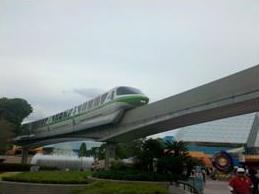 Alert III started out being a project simply focusing on proper flight attendant training and how that affects occupant survivability in combination with ARFF. After acquiring a few different textbooks and other resources, I decided to change the scope of the project to focus on everything that affects an occupant’s survivability and the responsibility between the two major players, flight crew and ARFF. While Alert III’s purpose was initially something completely different then what it turned out to be, it still achieved the goal of increasing awareness for not what only educating people in the need for survivability but also what affects survivability.
Alert III started out being a project simply focusing on proper flight attendant training and how that affects occupant survivability in combination with ARFF. After acquiring a few different textbooks and other resources, I decided to change the scope of the project to focus on everything that affects an occupant’s survivability and the responsibility between the two major players, flight crew and ARFF. While Alert III’s purpose was initially something completely different then what it turned out to be, it still achieved the goal of increasing awareness for not what only educating people in the need for survivability but also what affects survivability.
Although I haven’t studied other accidents in as much depth as Lexington, Lexington type accidents have and are happening where there are occupants alive when the aircraft finally stops and for one reason or another, the dominos fall and the fatality rate spikes. I cannot stress enough the need for effective communication in our industry because one small disconnect in communication or situational awareness can change a survivable accident into a death that shouldn’t have happened. It is important for Air Traffic Control, Flight Crews (Cabin and Flight Deck), as well as ARFF to come together and to work together as an emergency unfolds to change a matter of life and death.
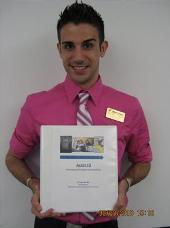 I have learned to never take for granted a takeoff climb or landing roll-out because I know the living hell and panic that people have gone through in our industry’s worst accidents. It is the events that follow in the wake of an accident that will dictate whether those involved walk away from it or not.
I have learned to never take for granted a takeoff climb or landing roll-out because I know the living hell and panic that people have gone through in our industry’s worst accidents. It is the events that follow in the wake of an accident that will dictate whether those involved walk away from it or not.
Finally, knowing that the challenges of survivability are huge undertakings, I found that if you are committed to the lives of the people who are sitting in a burning aircraft and you are the person who knows they are making a difference in saving their life, those undertakings quickly become one of the most amazing and self-fulfilling feelings ever. Since an accident happens so fast and for the occupants and their families there is no reset button, having the highest possible occupant survival rate is crucial in our industry when an accident does occur. On our continued road to a safer aircraft cabin environment…


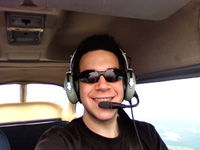 Every pilot, it seems, knows from the very beginning that he/she wants to pursue a career in aviation. I knew it the second I stepped foot into the cockpit of a FedEx Express Boeing 727 at Newark Airport. Even though I had no clue what I was looking at or what I was doing for that matter, it seemed just as cool then as it does now.
Every pilot, it seems, knows from the very beginning that he/she wants to pursue a career in aviation. I knew it the second I stepped foot into the cockpit of a FedEx Express Boeing 727 at Newark Airport. Even though I had no clue what I was looking at or what I was doing for that matter, it seemed just as cool then as it does now.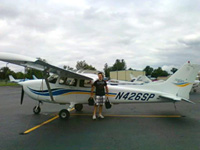 I was an A- student in high school and I was a member of both the National Honor Society and the Italian Honor Society. Throughout high school I enrolled in as many dual enrollment courses as possible and took AP exams during my senior year. All of which turned into seventeen transfer credits to the University. I’ve basically wiped out a semester for a fraction of the cost. I definitely recommend it, because it’s a good eye-opener to college coursework, and because you can’t beat the prices.
I was an A- student in high school and I was a member of both the National Honor Society and the Italian Honor Society. Throughout high school I enrolled in as many dual enrollment courses as possible and took AP exams during my senior year. All of which turned into seventeen transfer credits to the University. I’ve basically wiped out a semester for a fraction of the cost. I definitely recommend it, because it’s a good eye-opener to college coursework, and because you can’t beat the prices.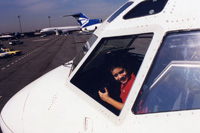 The remainder of my senior year of high school, involved a program called “Senior Seminar.” A class where each student enrolls him/herself in an internship; I choose flight training to become a pilot. To receive my flight training I attended a local flight school at Essex County Airport (Caldwell). I enrolled in a Part 141 training program to ultimately receive a private pilots certificate. I started out learning the basics during ground school, which was one-on-one with my flight instructor. I preferred this method over large classes, because it offers the student a better understanding of the material. In addition, my school had a full video library available to its students for training purposes, to reinforce each lesson. I highly recommend these videos from Jeppesen and King Schools to better any pilot during flight training. Throughout the course I learned many operations, maneuvers, and gained a knowledge about the aviation world. Overall I was loving every minute of it!
The remainder of my senior year of high school, involved a program called “Senior Seminar.” A class where each student enrolls him/herself in an internship; I choose flight training to become a pilot. To receive my flight training I attended a local flight school at Essex County Airport (Caldwell). I enrolled in a Part 141 training program to ultimately receive a private pilots certificate. I started out learning the basics during ground school, which was one-on-one with my flight instructor. I preferred this method over large classes, because it offers the student a better understanding of the material. In addition, my school had a full video library available to its students for training purposes, to reinforce each lesson. I highly recommend these videos from Jeppesen and King Schools to better any pilot during flight training. Throughout the course I learned many operations, maneuvers, and gained a knowledge about the aviation world. Overall I was loving every minute of it! Today was the final banquet for all the interns and co-ops. They showed up a really cool video about the launch day of the BIRST Project I talked about last time. I’m hoping they publish it on YouTube so I can share it with you guys. Sometimes pictures are proprietary information so anything that you want to distribute outside of the company has to go through an approval process. At the banquet my payload team presented our mentor with a trophy we made. One of the interns had a trophy from when he was younger and we wrapped the little topper man in duct tape (symbolic of the duct tape on the payload) attached an alien paratrooper to one outstretched hand and a mini Ball flag to the other hand. Then to represent all the epoxy we used on our project we dripped some over the trophy which had a final appearance a little like gloopy icicles. Overall the present was quite ugly but it wasn’t our goal to make something attractive, just something to signify the summer fun.
Today was the final banquet for all the interns and co-ops. They showed up a really cool video about the launch day of the BIRST Project I talked about last time. I’m hoping they publish it on YouTube so I can share it with you guys. Sometimes pictures are proprietary information so anything that you want to distribute outside of the company has to go through an approval process. At the banquet my payload team presented our mentor with a trophy we made. One of the interns had a trophy from when he was younger and we wrapped the little topper man in duct tape (symbolic of the duct tape on the payload) attached an alien paratrooper to one outstretched hand and a mini Ball flag to the other hand. Then to represent all the epoxy we used on our project we dripped some over the trophy which had a final appearance a little like gloopy icicles. Overall the present was quite ugly but it wasn’t our goal to make something attractive, just something to signify the summer fun.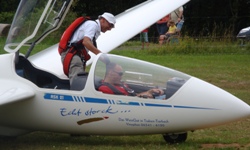 After taking the train out of Munich, we arrived in the small town of Traben-Trarbach around lunch on the 13th. We dropped off our things at the quaint little hotel, and headed up to Mont Royal for our glider flights! I was a little nervous about being shot up in the air, and I let a lot of people go before me. However I finally gathered my courage, put on my parachute, and climbed into the glider. The take off was pretty intense, but it was a beautiful view and definitely a fun ride!!! I am very glad to have done this, and I definitely believe this was one of the highlights of the trip. You can check out the video of my take off from the airfield at
After taking the train out of Munich, we arrived in the small town of Traben-Trarbach around lunch on the 13th. We dropped off our things at the quaint little hotel, and headed up to Mont Royal for our glider flights! I was a little nervous about being shot up in the air, and I let a lot of people go before me. However I finally gathered my courage, put on my parachute, and climbed into the glider. The take off was pretty intense, but it was a beautiful view and definitely a fun ride!!! I am very glad to have done this, and I definitely believe this was one of the highlights of the trip. You can check out the video of my take off from the airfield at 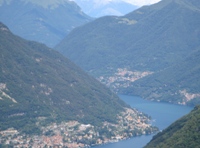
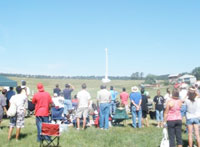 Hello everyone! I’ve been doing some sweeet things lately! The payload that I’ve been working on is FINALLY done! Last night we did some final “smoke bomb” testing. If you’ve ever seen the skydivers that jump and the stream of smoke comes out from behind them, we’re using one of those little devices, minus the skydiver of course. All of our little alien paratroopers were wrapped up and loaded into their piston shaft (it takes a very long time to preflight those little guys, wrapping each of their parachutes precisely). And then today we launched! We went to a ranch out in the middle of nowhere in Kiowa, CO.
Hello everyone! I’ve been doing some sweeet things lately! The payload that I’ve been working on is FINALLY done! Last night we did some final “smoke bomb” testing. If you’ve ever seen the skydivers that jump and the stream of smoke comes out from behind them, we’re using one of those little devices, minus the skydiver of course. All of our little alien paratroopers were wrapped up and loaded into their piston shaft (it takes a very long time to preflight those little guys, wrapping each of their parachutes precisely). And then today we launched! We went to a ranch out in the middle of nowhere in Kiowa, CO. There were 4 different launches scheduled. The first was a rocket made by an employee of ULA, it was 10ft tall and flew to like 5,000ft above ground level (AGL). The second was about 2 ft tall and was a scale model of a V-2 rocket and it went to 4,000 ft AGL, the third was called “The Boomer” and launched to about 13,000ft! It was awesome! Then our rocket was launched, it had 10 payloads total (because the payload that I worked on had 4 sub payloads). For anyone that is familiar with model rockets, we flew on a class N engine.
There were 4 different launches scheduled. The first was a rocket made by an employee of ULA, it was 10ft tall and flew to like 5,000ft above ground level (AGL). The second was about 2 ft tall and was a scale model of a V-2 rocket and it went to 4,000 ft AGL, the third was called “The Boomer” and launched to about 13,000ft! It was awesome! Then our rocket was launched, it had 10 payloads total (because the payload that I worked on had 4 sub payloads). For anyone that is familiar with model rockets, we flew on a class N engine.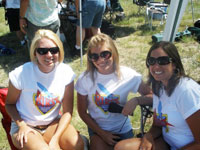 It took us a while to find all our payloads after launch. Since we were out in the middle of nowhere we had to trudge through a lot of brush and cactus, in the end we found our flag, smoke bomb, audio visual locator beacon, and about a dozen of the aliens. On my facebook I posted a video of the launch with my payload and also a video of “The Boomer.” There are also a lot more pictures. Check them out!
It took us a while to find all our payloads after launch. Since we were out in the middle of nowhere we had to trudge through a lot of brush and cactus, in the end we found our flag, smoke bomb, audio visual locator beacon, and about a dozen of the aliens. On my facebook I posted a video of the launch with my payload and also a video of “The Boomer.” There are also a lot more pictures. Check them out!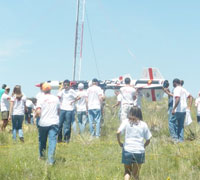 Some of my friends came into town last weekend and I went white water rafting! We decided to go on the “advanced beginner” route since we wanted a bit of a wild ride. The water was SOO cold. I suppose that makes sense because only a few hours before it was snow that was melted and ran into the creek. We also took further advantage of being in Colorado and did some serious hiking in Rocky Mountain National Park.
Some of my friends came into town last weekend and I went white water rafting! We decided to go on the “advanced beginner” route since we wanted a bit of a wild ride. The water was SOO cold. I suppose that makes sense because only a few hours before it was snow that was melted and ran into the creek. We also took further advantage of being in Colorado and did some serious hiking in Rocky Mountain National Park.
